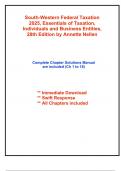South-Western Federal Taxation
2025, Essentials of Taxation,
Individuals and Business Entities,
28th Edition by Annette Nellen
Complete Chapter Solutions Manual
are included (Ch 1 to 18)
** Immediate Download
** Swift Response
** All Chapters included
,Table of Contents are given below
Chapter 1: Introduction to Taxation
Chapter 2: Working with the Tax Law
Chapter 3: Gross Income
Chapter 4: Business Deductions
Chapter 5: Losses and Loss Limitations
Chapter 6: Property Transactions: Basis, Gain and Loss, and Nontaxable
Exchanges
Chapter 7: Property Transactions: Capital Gains and Losses, Section 1231, and
Recapture Provisions
Chapter 8: Individuals as Taxpayers
Chapter 9: Individuals: Income, Deductions, and Credits
Chapter 10: Individuals as Employees and Proprietors
Chapter 11: Corporations: Organization, Capital Structure, and Operating Rules
Chapter 12: Corporations: Earnings & Profits and Distributions
Chapter 13: Partnerships and Limited Liability Entities
Chapter 14: S Corporations
Chapter 15: Comparative Forms of Doing Business
Chapter 16: Business Tax Credits and the Alternative Minimum Tax
Chapter 17: Multijurisdictional Taxation
Chapter 18: Taxes in the Financial Statements
,Solution and Answer Guide
NELLEN, CUCCIA, PERSELLIN, YOUNG, SWFT ESSENTIALS OF TAXATION: INDIVIDUALS AND
BUSINESS ENTITIES 2025, 9780357989197; CHAPTER 18: TAXES IN THE FINANCIAL
STATEMENTS
TABLE OF CONTENTS
Discussion Questions ...........................................................................................................1
Computational Exercises ................................................................................................... 6
Problems ............................................................................................................................. 9
Research Problems ........................................................................................................... 19
Solutions To Becker CPA Review Questions ................................................................... 20
DISCUSSION QUESTIONS
1. (LO 1) Taxable income differs from that reported in the financial statements primarily
because the two capture different constructs, meant for different purposes and for
different audiences.
2. (LO 1) Temporary differences are caused by income and expenses appearing in both
the financial statements and tax return but in different periods (i.e., a timing
difference). Permanent differences are caused by items appearing in the financial
statements or the tax return but not both. Both types of differences result in a gap
between book and taxable income. Temporary differences reverse over time, but
permanent differences do not.
3. (LO 1) Examples of temporary differences include the following:
• Cost recovery deductions for tax that differ in timing and amount from book
depreciation.
• GAAP requires use of the allowance method to recognize bad debt expense,
estimating the future collectibility of receivables related to prior sales. For tax
purposes, a deduction for a bad debt is not allowed until an account is identified
as uncollectible.
© 2025 Cengage. All Rights Reserved. May not be scanned, copied or duplicated, or posted to a publicly accessible 1
website, in whole or in part.
, • Warranty expenses accrued for book purposes but not deductible for tax purposes
until the services are provided.
• Goodwill is not expensed for book purposes unless and until impaired; § 197
permits the amortization of goodwill over 15 years.
Examples of permanent differences include the following:
• Municipal bond interest (i.e., nontaxable income).
• The disallowed portion of business meals expense (i.e., nondeductible expenses).
• Certain penalties.
• Federal income taxes.
• Tax credits.
4. (LO 2) SWFT, LLP
5191 Natorp Boulevard
Mason, OH 45040
November 17, 2024
Marcellus Jackson
Mac, Inc.
482 Linden Road
Paris, KY 40362
Dear Mr. Jackson:
A significant difference may exist between a corporation’s U.S. Federal income
tax liability as reported on its Form 1120 (tax) and the corporation’s income tax
expense as reported on its financial statements (book) prepared using generally
accepted accounting principles (GAAP). This difference is caused primarily by the
following:
• Different definition of taxes included in the income tax expense amount.
• Different accounting methods.
• Intra-period allocation.
• Different criteria for recognizing the benefits of uncertain tax positions.
Different Taxes. The income tax expense reported on a corporation’s financial
statements is the combination of Federal, state, local, and foreign income taxes. The
income tax expense reported on the Form 1120 is the current-year Federal income
tax expense only.
Different Methods. Due to the different purposes served by GAAP and taxable income,
the period in which revenues and expenses are recognized often differs across the
two measures. As a result, many items of revenue and expense, though recognized
for both book and taxable income, impact a company’s taxable income (and tax
liability) in a different year than when they are reported in its book income. However,
GAAP requires that all of the tax related to the net income reported in the current-
© 2025 Cengage. All Rights Reserved. May not be scanned, copied or duplicated, or posted to a publicly accessible 2
website, in whole or in part.




